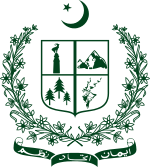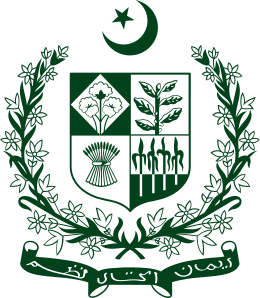Government of Gilgit-Baltistan
 Provincial Government Seal | |
| Seat of Government | Gilgit |
|---|---|
| Legislature | |
| Assembly | |
| Speaker | Fida Muhammad Nashad |
| Members in Assembly | 33 |
| Executive | |
| Governor | Mir Ghazanfar Ali Khan |
| Chief Minister | Hafiz Hafeezur Rehman |
| Judiciary | |
| High Court | Gilgit-Baltistan Supreme Appellate Court |
| Chief Justice | Muhammad Arshad Khan |
The Government of Gilgit-Baltistan (Urdu: حکومتِ گلگت بلتستان) is system of government based in Gilgit, Pakistan which stands as its capital.The Gilgit-Baltistan is one of the Five Provincial Governments of Pakistan.
Overview
The territory of present-day Gilgit-Baltistan became a separate administrative unit in 1970 under the name "Northern Areas." It was formed by the amalgamation of the former Gilgit Agency, the Baltistan District of the Ladakh Wazarat, and the hill states of Hunza and Nagar. It presently consists of ten districts, has a population approaching one million, an area of approximately 28,000 square miles (73,000 km2), and shares borders with rest of Pakistan, China, Afghanistan, and India.
Gilgit-Baltistan Empowerment and Self-Governance Order 2009
While administratively controlled by Pakistan since the first Kashmir war, Gilgit-Baltistan has not yet been formally integrated into the Pakistani state and does not participate in Pakistan's constitutional political affairs.[1][2] On August 29, 2009, the Gilgit-Baltistan Empowerment and Self-Governance Order 2009, was passed by the Pakistani cabinet and later signed by the President of Pakistan. The order granted self-rule to the people of Gilgit-Baltistan, by creating, among other things, an elected Gilgit-Baltistan Legislative Assembly and Gilgit-Baltistan Council. Gilgit-Baltistan thus gained de facto province-like status without constitutionally becoming part of Pakistan.[1][3]
Executive
The government of Gilgit Baltistan consists of democratically elected body with the Governor of Gilgit-Baltistan as the constitutional head.
The Chief Minister of Gilgit-Baltistan (CM) is elected by the Provincial Assembly of the Gilgit-Baltistan to serve as the head of the provincial government in Gilgit-Baltistan.
Departments
The Executive Consists of following department:[4]
- Home & Prisons Department
- Finance Department
- Law and Prosecution Department
- Services and General Administration, Information and Cabinet Department
- Revenue, Usher and Zakat, Excise and Taxation and Cooperative Department
- Food and Agriculture, Fisheries and Animal Husbandry Department
- Forest, Wildlife and Environment Department
- Education, Social Welfare and Women Development
- Health and Population Welfare Department
- Works Department
- Local Government, Rural Development and Census Department
- Water and Power Department
- Tourism, Sports, Culture and Youth Department
- Mineral Development, Industries, Commerce & Labour Department
- Planning and Development Department
Legislature
The Gilgit-Baltistan Legislative Assembly is a 33-seat unicameral legislative body. It has 24 directly elected members, 6 reserved seats are for women plus 3 seats are reserved for technocrats.[5]
Gilgit-Baltistan Council
The Gilgit-Baltistan Council has been established as per Article 33 of Gilgit-Baltistan (Empowerment & Self Governance) Order, 2009. Its Chairman is the Prime Minister of Pakistan and Governor of Gilgit-Baltistan is the Vice-Chairman. It can legislate on 53 subjects as provided in Schedule III of the Order. Other members include Chief Minister of Gilgit-Baltistan, 6 members are nominated by Prime Minister of Pakistan and 6 members are elected by Gilgit-Baltistan Legislative Assembly.[6]
Judiciary
Under Gilgit-Baltistan Empowerment and Self-Governance Order 2009 Gilgit-Baltistan Supreme Appellate Court was established with a Chief Justice and two other Judges. The chief judge and judges are appointed for a period of three years by the prime minister of Pakistan.[7]
See also
- Governor of Gilgit-Baltistan
- Chief Minister of Gilgit-Baltistan
- Gilgit-Baltistan Legislative Assembly
- Gilgit-Baltistan Council
References
- 1 2 "Gilgit-Baltistan: A question of autonomy". Indian Express. September 21, 2009. Retrieved 2013-02-23.
- ↑ Shigri, Manzar. "Pakistan's disputed Northern Areas go to polls". Reuters.com. Retrieved 2013-02-23.
- ↑ "DAWN: Gilgit-Baltistan autonomy". Archives.dawn.com. 2009-09-09. Retrieved 2013-02-23.
- ↑ Government of Gilgit Baltistan
- ↑ Government of Gilgit Baltistan
- ↑ "Gilgit-Baltistan Council". Gilgit-Baltistan Council. Retrieved 20 July 2013.
- ↑ Fresh appointment: Gilgit-Baltistan judicial crisis ends – The Express Tribune
